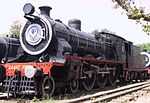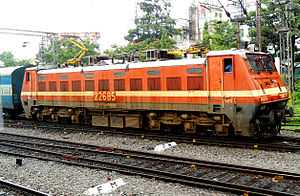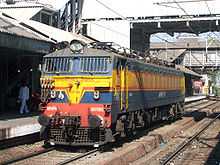Indian locomotive class WAP-6
| WAP-6[1] | |
|---|---|
| Type and origin | |
| Power type | Electric |
| Builder | CLW |
| Total produced | 17 |
| Rebuild date | August, 2012 |
| Number rebuilt | 22400-22415 |
| Specifications | |
| UIC classification | Co'-Co' |
| Gauge | 1,676 mm (5 ft 6 in) |
| Bogies | originally Flexicoil Mark IV Fabricated;converted to Co'-Co' Flexicoil Mark 1 cast bogies; primary and secondary wheel springs with bolsters |
| Wheel diameter |
New: 1,092 mm (3 ft 7 in) Half worn: 1,055 mm (3 ft 5 1⁄2 in) Full worn: 1,016 mm (3 ft 4 in) |
| Length | 18.79 m (61 ft 7 3⁄4 in) |
| Height | 4.235 m (13 ft 10 3⁄4 in) |
| Axle load | 18,800 kg (41,400 lb) |
| Locomotive weight | 113,200 kg (249,600 lb) |
| Electric system(s) | 25 kV 50 Hz AC, AC Overhead |
| Current collection method | pantograph |
| Traction motors | Hitachi HS15250 |
| Performance figures | |
| Maximum speed |
Intended at 160 km/h (99 mph); Restricted:140 km/h (87 mph) Upgrade:170 km/h (106 mph) |
| Power output |
Max: 5,350 hp (3,990 kW) Continuous: 5,060 hp (3,770 kW) |
| Tractive effort |
Starting:30.8 t (30 long tons; 34 short tons) Continuous:19 t (19 long tons; 21 short tons) |
| Locomotive brake | Air/Hand |
| Train brakes | Air |
| Safety systems | Slip control, Over voltage relay and No volt relay |
| Career | |
| Operator(s) | Indian Railways |
| Number(s) | 22400-22416 |
| Locale | Eastern Railway |
| Withdrawn | August, 2012 |
| Disposition | One scrapped remainder rebuilt |
The 6th class of Wide Gauge (W), Alternating Current powered (A), Passenger-dedicated (P) series.
This class was actually variant of the WAP-4 design where Co-Co Flexicoil Mark 1 cast bogies of the usual WAP4 was replaced by Fabricated Flexicoil Mark IV bogies. All other specifications were same as WAP4. WAP-1 unit no. 22212 was the first to be rebuilt into a WAP-6. It was provided with Flexicoil bogies and other upgrades. Then it was rebuilt into WAP-4. Later, more WAP-1 units were re-geared and provided with high-adhesion fabricated bogies (Flexicoil Mark IV) which are somewhat similar to ALCO hi-adhesion bogies. They were intended to reach 160 km/h (99 mph) but failed to do so in trials and were restricted at 140 km/h (87 mph). Two units,i.e., 22406 and 22408 are upgraded with better wheel-sets. This class was an unsuccessful one. All have been converted back as WAP-4. All were homed at Asansol(ASN) shed but after conversion reallocated to Howrah (HWH)shed.[2]
Technical specifications
| Technical specification[3] | |
|---|---|
| Traction motors | Axle-hung, nose-suspended, force-ventilated, 3,485 kg (7,683 lb), 630 kW (840 hp), 750 V, 900 A, 895 RPM, parallel grouping, C class armature and field, temperature rise (Armature 60, filed 70 and commutator 85) in °C, coil resistance (armature 0.01284 ohms+10%, field 0.01184 ohms+10% and commutator 0.00907 ohms+10%, air gap main pole 6.35 kVA, air gap inter-pole 10 mm (0.3937 in) |
| Gear ratio | 58:23 |
| Transformer | CCL make, aluminium coil, 3400 kVA, 32 taps |
| Rectifier | 2 silicon rectifier cubicle 2700 A, 1050 V |
| Number of sandboxes | 4 |
| 2 Headlights | 250 W, 32 V |
| Lead acid Battery | 50 cells, 110 V (rated 5 hr) |
| Arno Converter | 216 kVA |
| 2 FLAKT smoothing reactor blower | PHMX-40 |
| 2 Silicon Rectifier Blower | 60 kg (132 lb) |
| Oil cooler blower | S.F. India Ltd. |
| Smoothing reactor for traction motor | SL-30 type, 1350 A, 1270 V, 2 Coils, 0.00535 ohms resistance at 110 °C (230 °F) |
Hauling capacity
If the average weight of ICF coaches is 55 tonnes then:
| Grades/km/h | Start | 20 | 40 | 60 | 70 | 80 | 90 | 100 | 110 | 120 | 130 | 140 | 150 | 160 |
|---|---|---|---|---|---|---|---|---|---|---|---|---|---|---|
| Level | 1500+ | 1500+ | 1500+ | 1500+ | 1500+ | 1500+ | 1500+ | 1500+ | 1500+ | 1500+ | 1500+ | 1155 | 805 | 570 |
| 1 in 500 | 1500+ | 1500+ | 1500+ | 1500+ | 1500+ | 1500+ | 1500+ | 1500+ | 1500+ | 1500+ | 1105 | 805 | 565 | 400 |
| 1 in 200 | 1500+ | 1500+ | 1500+ | 1500+ | 1500+ | 1500+ | 1500+ | 1320 | 1230 | 1035 | 730 | 535 | 375 | 260 |
| 1 in 150 | 1500+ | 1500+ | 1500+ | 1500+ | 1500+ | 1500+ | 1405 | 1090 | 1020 | 860 | 610 | 445 | 310 | 215 |
| 1 in 100 | 1500+ | 1570 | 1490 | 1405 | 1365 | 1195 | 1020 | 795 | 750 | 635 | 445 | 320 | 220 | 145 |
| 1 in 50 | 1160 | 770 | 750 | 720 | 710 | 625 | 530 | 410 | 390 | 325 | 220 | 150 | 90 | 45 |
Trains hauled by WAP-6
- Amritsar Express
- Doon Express
- Janata Expresses
- Howrah New Delhi Duronto Express
- Sealdah New Delhi Duronto Express
- Howrah Patna Janshatabdi Express
- Purushottam Express
- Bhubaneshwar Rajdhani Express
See also
References
| ||||||||||||||||||||||||||||||||||||||||||||||||||||||||||||||||||||||||||||||



